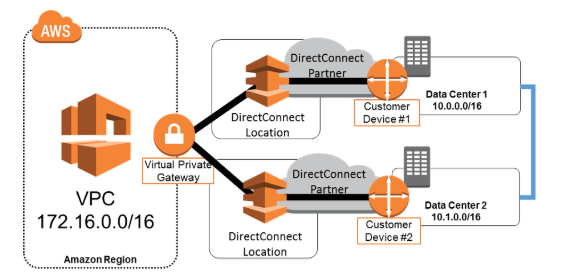Maximum Fault Tolerance and Bandwidth for AWS Direct Connect Connection
Question
Your company is planning to set up an AWS Direct Connect connection to an AWS VPC.
They want to achieve maximum fault tolerance and have maximum bandwidth at all times.
How can this be achieved?
Answers
Explanations
Click on the arrows to vote for the correct answer
A. B. C. D.Answer - A.
Options B and C are incorrect because there should only be one Virtual Private gateway.
Option D is incorrect because since you need maximum bandwidth at all times, having a backup VPN is not preferred.
The below architecture diagram from the AWS Documentation mentions how this high availability can be achieved.
For more information on high network connectivity, please refer to the below URL.
https://aws.amazon.com/answers/networking/aws-multiple-data-center-ha-network-connectivity/
In order to achieve maximum fault tolerance and have maximum bandwidth at all times while setting up an AWS Direct Connect connection to an AWS VPC, we need to consider redundancy and high availability in the setup. This can be achieved by using multiple components that can act as failovers for each other.
Option A suggests using one Virtual Private Gateway, two AWS Direct Connect Locations, and two Customer Gateways. This option provides redundancy by having two Direct Connect Locations and two Customer Gateways. If one Direct Connect Location or Customer Gateway fails, the other one can take over the traffic. This option also provides maximum bandwidth by having two Direct Connect Locations.
Option B suggests using two Virtual Private Gateways, two AWS Direct Connect Locations, and one Customer Gateway. This option provides redundancy by having two Virtual Private Gateways and two Direct Connect Locations. If one Virtual Private Gateway or Direct Connect Location fails, the other one can take over the traffic. This option also provides maximum bandwidth by having two Direct Connect Locations.
Option C suggests using two Virtual Private Gateways, one AWS Direct Connect Location, and one Customer Gateway. This option provides redundancy by having two Virtual Private Gateways. However, it only has one Direct Connect Location, which can be a single point of failure. This option does not provide maximum bandwidth as there is only one Direct Connect Location.
Option D suggests using one Virtual Private Gateway, one AWS Direct Connect Location, one VPN connection, and two Customer Gateways. This option does not provide redundancy as there is only one Direct Connect Location and one Virtual Private Gateway. It also does not provide maximum bandwidth as there is only one Direct Connect Location.
Therefore, the best option for achieving maximum fault tolerance and maximum bandwidth at all times is Option A, which suggests using one Virtual Private Gateway, two AWS Direct Connect Locations, and two Customer Gateways.
